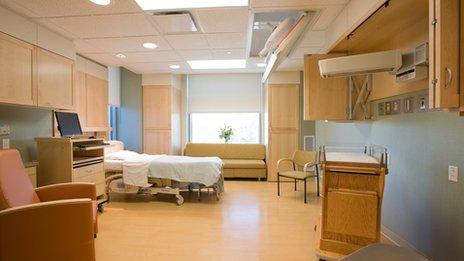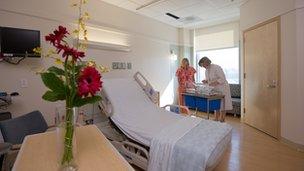Can statistics cut the cost of US healthcare?
- Published

Intermountain says it has dramatically improved its outcomes for patients by using data to spot areas that need to be streamlined
As the US Supreme Court prepares to issue its long-awaited ruling on President Barack Obama's healthcare reforms, hospitals across the country are finding their own ways to tackle the rising costs of healthcare.
The debate over what people have come to call "Obamacare" has been polarising and highly ideological. That's hardly surprising, since healthcare accounts for a little under one-fifth of the US economy.
But far from Washington, in the mountain state of Utah, a quiet revolution has been taking place in ways to reduce costs while simultaneously improving quality.
"Every area we've touched, we've been able to improve," says Dr Brent James, chief quality officer at Intermountain Healthcare in Salt Lake City. "We do not yet begin to know how good we can be."
For almost 20 years, Dr James and his colleagues have been doing their best to find out just how good they can be, thanks to a painstaking audit of everything the network of 23 hospitals and around 100 clinics does.
With a background in physics, as well as medicine, Dr James calls himself "a total geek". But he is a geek with a mission: to help his doctors really see what they are doing.
"Most of what happens in medicine today, the effect size is so small that you can't see it with the naked eye," he says.
"Well, imagine a circumstance in which I give my physicians eyes. I give them data."
Lots and lots of data.
Data drive
Take childbirth: for reasons of convenience, for parents and doctors alike, a lot of babies in America are born a week or two early.
In the late 1990s, when elective inductions were becoming increasingly common, Intermountain looked at the numbers.
"We found that babies born without a solid obstetrical indication at 37 or 38 weeks were more likely to be sick," says Dr Ware Branch, Director of Women and Newborn Services.

Rising healthcare costs have the potential to bankrupt the US
The problems with breathing or maintaining good body temperature were generally considered to be relatively minor but babies frequently ended up in the neo-natal intensive care unit, where stays can run at anywhere from $1,500 (£970) to $3,000 a day.
Intermountain reduced the number of unnecessary deliveries, improving the health of its babies and saving millions of dollars in the process.
The same data-driven spotlight has been turned on almost every procedure the hospital performs.
Death rates from heart bypass surgery and pneumonia have dropped dramatically. The same goes for sepsis, the primary cause of death in modern hospitals.
Before a new set of protocols was introduced, Intermountain's mortality rate from sepsis was a respectable 20.2% (across the country, it averages between 20-50%). Three years later, it was 6%.
Probability for physicians
As far as Brent James is concerned, the sky's the limit.

Brent James insists medicine should learn from other disciplines where data has driven change
"We have not yet found an area we've not been able to improve," he says. "We count our success in lives."
After pregnancy and labour, heart conditions make up a huge proportion of the hospital's work. Intermountain has drawn on all the evidence it has to refine its procedures: reducing variation in treatment, summarising and constantly updating complex guidelines.
And, if it sometimes sounds like the sort of process management theory promoted by the late Edwards Deming, whose work had a major impact on Japanese manufacturing and who helped to turn around Ford's fortunes in the early 1980s, it is not surprising.
Dr James met the legendary statistician in 1987 and says he was inspired to bring his insights to a new field.
"What we're proposing is not new," he insists. "There are so many examples of this in other fields. But it's new to medicine."
Doctors, he says, are great at figuring out what is wrong with people, but less good at knowing what course of treatment will work.
"As physicians, we're really good at recognising a set of circumstances," he says, "but we're no good at doing probability estimations."
For doctors, this is all about letting the data inform and guide their decision-making process.
'Breaking the logjam'
Dr Donald Lappe, chairman of Intermountain's cardiovascular department, says it is about applying logic. And like his colleagues, he is not afraid to make bold claims.
"All those 40 or 50 million uninsured people could be afforded care to the level we provide if everyone practiced the same efficiency and effectiveness of their delivery of healthcare."
Other hospitals have experimented with high-quality care at a lower cost, but few have conducted such a forensic overhaul with such dramatic results.
Dr James and his colleagues are not afraid to evangelise for the approach they call, simply, "organised care."
Other networks are following suit - Dr James credits the Affordable Care Act for "breaking the logjam" - but overall the American system still prefers to reward providers for volume, not outcome.
"That's what we as patients have grown to expect," says David Grauer, Intermountain's chief administrator and chief executive. "But it cannot be sustained. It has to change."
In America, the rising cost of healthcare has the capacity to bankrupt the nation.
National healthcare expenditure is expected to top $3tn in 2012. Some estimates see it reaching $4.6tn by 2020.
But Dr James claims that a little under 50% of that is technically waste, through a combination of inefficient payment mechanisms and poor quality control.
"So, in my more grandiose moments, before my colleagues track me down and adjust my medications," says Dr James with a wry smile, "I believe that what we're talking about here is not just the salvation of healthcare. I believe it's the salvation of the United States."
- Published20 June 2012
- Published27 March 2012